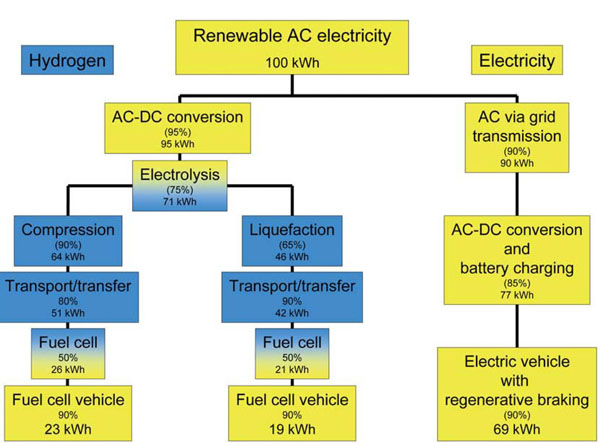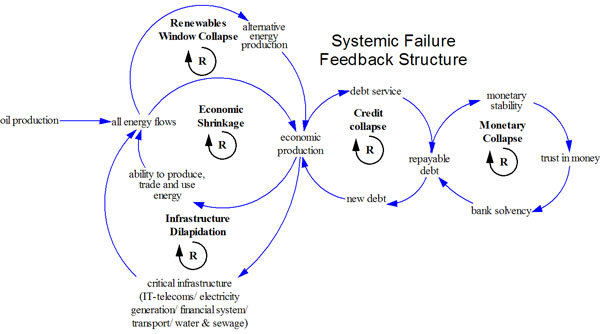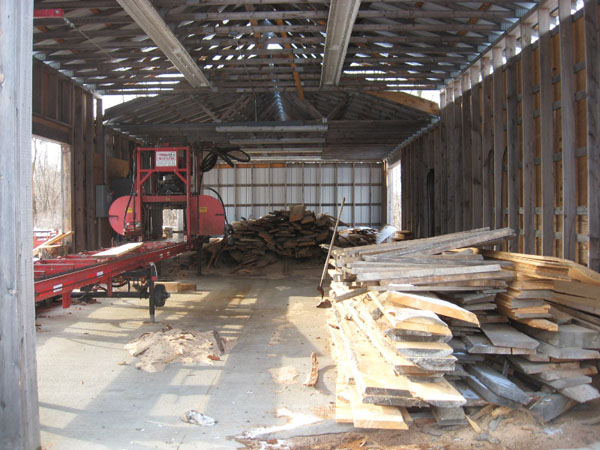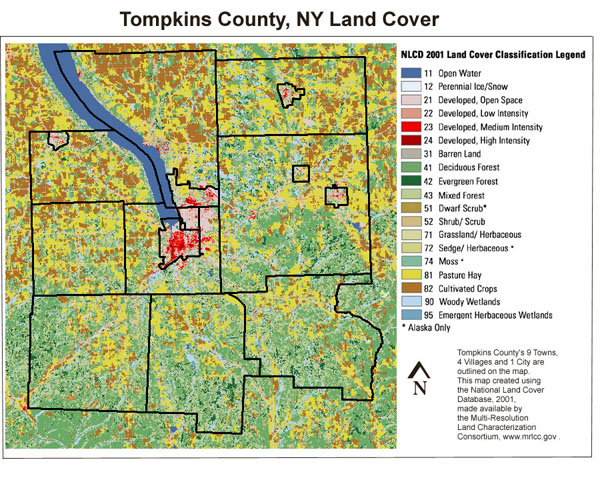Recently in energy production Category
by Jon Bosak
As our regular readers know, we here at TCLocal are engaged in a long-term effort to help develop local responses to energy descent—the condition of decreasingly available energy. The near-term manifestation of energy descent is high liquid fuel prices caused by a leveling and decline in global oil production, and it has been part of our job over the five years since we started TCLocal to keep an eye on the liquid fuel outlook and periodically advise the residents of Tompkins County (in particular, local policy makers) on what we’re finding.
In September, five of us TCLocal contributors had the honor of presenting a panel discussion on “Local Responses to Energy Descent” at the monthly meeting of Back to Democracy in Trumansburg. The audience heard from Katie Quinn-Jacobs on Preparedness; Karl North on Food Production; Bethany Schroeder on Health Care; and Tom Shelley on Energy. Articles by all of these authors can be found elsewhere on the TCLocal.org web site (see the list at the end of this article). It was my job to introduce these responses to energy descent with a quick summary of the outlook for liquid fuels. A version of that introductory presentation serves as our TCLocal article for the months of September and October.
The overview that follows was based on a fresh analysis of the current situation conducted over the summer by a team consisting of myself, Bethany Schroeder, Karl North, and Tom Shelley. Not every detail will be agreed upon by every TCLocal contributor or even by every member of the research team, but it does represent in a general way a shared view of the outlook for liquid fuels over the next decade. Illustrations drawn from the Web are credited where the source is known and are reproduced here under the Fair Use provisions of copyright law.
The Lesson of Deepwater Horizon
Predicting the price of oil is an extraordinarily difficult task even for petroleum experts, which we are not, and the effect of the economic downturn on the oil business has made reliable forecasting almost impossible for the last couple of years. But this summer, one thing, at least, became very clear: the easy oil is gone. That’s not a future development; it’s already here.
U.S. Coast Guard
No one pursues a course as risky, dangerous, and expensive as drilling four miles down into the Gulf of Mexico unless all the easier stuff is no longer available. It doesn’t take a degree in petroleum engineering to see this.
It is enlightening to understand some basic facts about oil extraction, though, so if you’d like to know more about that, click here. You’ll be returned back to this place when you’re done.
Here’s a recently published official view of the future from the U.S. Department of Energy’s Energy Information Agency (EIA).
The top line in this remarkable graph is world demand for liquid fuels. Over the long term it always increases steadily due to population growth, if nothing else.
The colored areas show the global sources of liquid fuels, taking into account all currently known projects. As the graph makes clear, existing sources of conventional oil are already in steep decline, and unconventional sources can’t keep up with that decline. The result is a growing gap between supply and demand beginning not long after 2012.
In the petroleum world, this has never happened before. Up until now, there has always been enough liquid fuel to meet demand, because it could be pumped out as fast as people had a use for it. A widening gap between supply and demand will eventually have an upward effect on prices beyond anything seen so far.
The label “Unidentified Projects” in the illustration acknowledges that no one really knows what sources can fill this widening gap between supply and demand. It is certain that no combination of currently foreseeable efforts can make up for the rate of decline in conventional oil production, and any new projects are certain to be much more expensive than those of the past.
Red Herrings and Dead Ends
At this point, most readers will be thinking of their favorite solution to the energy problem. But within the ten-year period that we’re discussing here, there is no solution. No current proposal will avert a near-term future of decreasingly less available liquid fuel.
This conclusion may come as a shock to anyone who’s put their faith in technological fixes. We seem to have so many promising solutions to choose from; you’d think the problem was just getting them implemented. There certainly is a lot we could be doing that we aren’t, but on examination it turns out that the proposed technological solutions to the coming oil crunch are at best wishful thinking and at worst border on the fraudulent.
A prime example of this latter category is the idea that we will replace current vehicles with ones fueled by hydrogen. The fact is that hydrogen is not a source of energy, it’s just a way of storing energy, like batteries. And if we had the extra energy to store, we could distribute it much more easily by building out the existing electric grid—and much more efficiently, too. As shown here, the pure electric approach delivers three times the power to the road from a given input of electricity than the hydrogen-based approach.
Bossel, Proceedings of the IEEE
Remember GM’s relentless promotion of hydrogen cars? The last serious publicity the company put into this was in 2006. It’s now obvious that this was all just a PR campaign designed to reassure consumers that GM was working toward a transition away from fossil fuels. That role is now being played by electric cars. This is an improvement, but unfortunately not a solution.
The proposal to solve the liquid fuels problem by transitioning to electricity is one of a large class of putative solutions that make some technical sense but just don’t comprehend the scale of the problem. It’s clear that widespread conversion to electric vehicles will require some kind of addition to our generating capacity, but few people appreciate the size of the change. The fact is that most people have no idea how much energy we’re consuming to move as many vehicles around as we do.
Let’s do a little back-of-the-envelope calculation here. According to the EIA, total U.S. petroleum consumption in 2007 was 20,680,000 barrels per day, and 70 percent of it went to transportation. A barrel of oil represents 1700 kWh of energy. Do the arithmetic and you’ll find that transportation in the U.S. uses about 9.0 billion MWh/year of energy from petroleum. By comparison, according to the EIA, total U.S. electrical output in 2007 was about 4.2 billion MWh. In other words, the amount of energy represented by the fuel we’re using in vehicles is more than twice as much as the total amount of energy represented by the electricity we’re producing each year. Speaking very roughly, therefore, a proposal to replace half of our vehicle fleet with electric versions amounts to a proposal to double the size of our entire electric generating and distribution system, which includes doubling the amount of fuel consumed (chiefly coal). It is safe to assume that we will not see this happening in the next ten years, if ever.
Proposals that rely on solar, wind, or nuclear to provide the missing electricity demonstrate a similar failure to understand the scale of the problem. The following diagram illustrates this point.
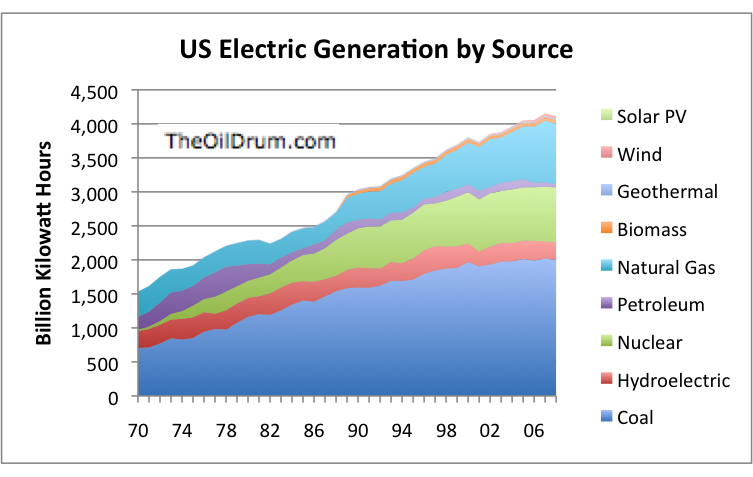
Count off the sources by working up from the bottom of the graph and you’ll begin to understand what a tiny proportion of our electrical generating capacity is due to wind, solar, and biomass; their contribution is barely visible. Electricity from nuclear is much greater, of course, but the cost and planning horizon of nuclear projects means that any sizable expansion of nuclear capacity would lie many years in the future. Aside from the inability of these sources provide liquid fuel, no believable expansion scenario envisions any combination of them being able to fill more than a fraction of the energy gap that’s opening up due to the decline of conventional oil.
A third class of solutions would actually solve the liquid fuel problem, but only for a little while, and at an enormous cost in other resources. Hydrofracking for natural gas in our local Marcellus shale is an example of this category of solutions: we get a temporary shot of fossil fuel at the cost of our farms and our drinking water, and at the end of the process we're left back where we started but with permanent damage to our environment.
Another technology in this category is oil from “tar sands” and “oil shales,” production of which uses phenomenally large amounts of water and is even more destructive to the environment than hydrofracking.
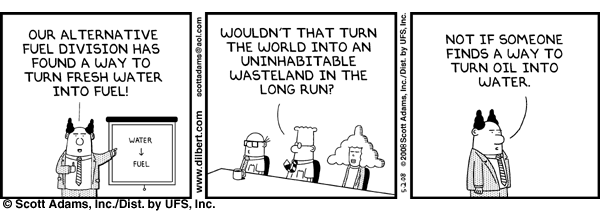
Tar sands are also representative of a class of good-looking production technologies that don’t yield significantly more energy than they use but simply substitute one source of energy for another, in this case, massive amounts of natural gas to heat the “tar” (bitumen). Another example of an energy “source” that doesn’t actually deliver significantly more energy than it consumes is liquid fuel from biomass, such as ethanol from corn.
To sum up, then: some of these alternatives—in particular, the development of solar and wind power—really are worth pursuing, but none of the current proposals can change the history of the next decade or so, either because they are not solutions at all or because it is physically impossible to increase production from alternative sources quickly enough to have a meaningful impact in that period of time. The only thing that could change the basic reality would be a massive, all-out effort to replace liquid fuels with substitutes from coal or natural gas.
Large-scale production of liquid fuels from coal has only been accomplished twice in history, once by the Nazi government in Germany and once by the apartheid regime in South Africa; the synthetic fuel is of excellent quality, but the technology is brutally expensive and therefore instituted only as a last resort. And of course large-scale coal-to-liquids would just delay the inflection point without really changing anything, because coal and natural gas are themselves finite resources that are closer to their own peaks than most people realize.
Coal-to-liquids shares one more flaw with most of the other proposed solutions: we’re out of time. A 2005 study commissioned by the U.S. Department of Energy concluded that widespread disruption to our economic system from peak oil could be averted by nothing less than a WW2-level national mobilization effort to implement coal-to-liquids starting at least a decade ahead of the peak—and we don’t have that kind of time left.
Timing the Gap
The inevitability of a coming liquid fuel price crisis caused by failure of oil production to meet increasing demand is much easier to establish than the precise timing of that crisis. But this year several independent studies have arrived from different directions at approximately the same conclusion.
In “The Status of Conventional World Oil Reserves,” published recently in the journal Energy Policy, researchers Owen, Interwildi, and King conducted an in-depth survey of all currently available information regarding oil production and petroleum reserves, with special attention to the reliability of reporting in the OPEC countries. Their conclusion:
Supply and demand is likely to diverge between 2010 and 2015, unless demand falls in parallel with supply constrained induced recession.
Note the “unless”; we’ll return to that shortly.
In the article “Forecasting World Crude Oil Production Using Multicyclic Hubbert Model,” published last April in Energy & Fuels 2010, a team from Kuwait University (Nashawi, Malallah, and Al-Bisharah) performed an in-depth mathematical analysis of the 47 leading oil-producing countries. While based on a methodology completely different from that used by Interwildi et al., their findings are strikingly similar:
World oil reserves are being depleted at an annual rate of 2.1%.... World production is estimated to peak in 2014....
A third independent study is notable for its source: the United States Joint Command (that is, the U.S. military establishment). Their official public assessment of the current situation, published last February in Joint Operating Environment 2010, is short on detail but very clear:
By 2012, surplus oil production capacity could entirely disappear, and as early as 2015, the shortfall in output could reach nearly 10 MBD.
Ten million barrels per day (MBD) is about 12 percent of current global oil production. A shortfall of that magnitude would have an effect on fuel prices that’s difficult to fully imagine.
The mainstream business press has until recently been notably dismissive of such estimates, regardless of the credibility of their sources (how can you dismiss the entire U.S. military?). But in September, Forbes, which bills itself as the “capitalist tool,” broke the wall of denial in an interview with respected oil analyst and oil industry veteran Charles Maxwell (nicknamed “the Dean of Oil Analysts”). Maxwell said:
A bind is clearly coming. We think that the peak in production will actually occur in the period 2015 to 2020. And if I had to pick a particular year, I might use 2017 or 2018. That would suggest that around 2015, we will hit a near-plateau of production around the world, and we will hold it for maybe four or five years. On the other side of that plateau, production will begin slowly moving down. By 2020, we should be headed in a downward direction for oil output in the world each year instead of an upward direction, as we are today.
As might be expected, the estimate in Forbes is the most conservative of the forecasts quoted here, but even it clearly sees a fundamental change in the liquid fuels supply before the end of the decade.
These are just the most recent in a series of warnings by eminently credible sources dating back to 2004. For some earlier quotes, click here.
Now let’s take another look at that first study. It says that supply and demand are likely to diverge between 2010 and 2015, unless demand falls in parallel with supply constrained induced recession. In other words, this forecast, like the rest, is based on the assumption that the economy stays healthy, because (as just happened) an economic downturn reduces the demand for liquid fuels. So we can sum up all four of these recent analyses in one conclusion:
IF the economy stays healthy, THEN supply shortages or very high prices will begin to develop before the end of this decade, probably some time between 2012 and 2015.
In forecasting the timing, therefore, the operative question is, How likely is it that the economy will stay healthy? And the answer is, Not very. This is because fuel prices and the economy have become deeply interdependent. Just as a bad economy causes fuel prices to fall (as we saw in 2008), so high fuel prices cause the economy to fall. An often cited threshold is $85 per barrel, above which the price of fuel has a damaging effect on the economy. Our current economic downturn was about bad credit and a real estate bubble, but some analysts suspect that the first card to be pulled out of the house of cards was the spike in oil prices that briefly drove crude to $145 a barrel.
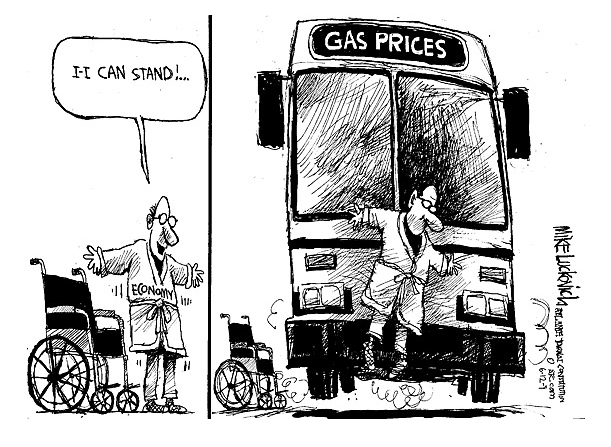
Instead of the steady decline shown in the EIA graph, we may see a period of boom-and-bust cycles where a rising economy causes a rise in fuel prices followed by an economic downturn and falling fuel prices. If this happens, the point at which global demand permanently exceeds global supply may, contrary to all the estimates quoted above, be pushed clear into the next decade. But this does not affect the basic finding that, as a society, we will soon use much less liquid fuel, for several reasons.
First, from here on out, both sides of the boom-and-bust cycle limit the amount of fuel we will be consuming on average. Either we will be employed but unable to afford the high fuel prices associated with a good economy, or we will have lower fuel prices in an economic downturn but be unable to buy any because we’re unemployed.
Second is the fact that the U.S. imports most of its oil. So for us, the question is not how much oil is being produced globally, but how much of it is available for import. And from this viewpoint, the picture looks very dark indeed. All the big oil exporting countries have internal development needs to meet at the same time that almost all of them are producing less oil every year. The combination of increasing internal consumption and decreasing oil production can very quickly send exports from a given country to zero.
A third factor that guarantees less fuel available to us in the future is China’s quiet acquisition of long-term contracts with major oil producers, which will take a lot of oil out of the open market we’ve been depending on to supply our needs.
Finally, the notion that the global economic cycle will be driven by our national vicissitudes is based on the assumption that the world economy depends on the U.S. economy. That’s been true till now, but the moment the Chinese realize that instead of lending us money to buy their products, they can lend themselves the money to buy their products, we fall out of the picture, and at that point we may well find ourselves with a decreasing ability to pay for fuel that is becoming increasingly expensive, with prices driven upward by an Asian economic expansion that has decided to go on without us.
A Dangerous Situation
The more we consider the dependence of our economy on cheap fuel, the more fragile it appears. Everything about the American economy is based on the assumption that growth is inevitable; indeed, compound interest itself—the bedrock of our financial system—is based on this concept insofar as it represents actual growth and not just inflation. Take that growth away, and the whole thing collapses, as we saw when real estate prices stopped increasing.
The unprecedented disappearance of spare liquid fuel production capacity makes the system highly vulnerable to interruptions in supply, as diagrammed here by TCLocal contributor Karl North; a problem with oil production (far left) can set in motion a set of feedback loops that brings down the entire economic system. From this perspective, our current situation is actually rather precarious.
While it’s devoutly to be hoped that we can get past the inflection point of oil production with our society more or less intact, no one should underestimate the downside potential of this development. Another recent objective analysis, this one carried out by the German Army (the Bundeswehr), summed up the consequences of declining oil production for their country this way:
Investment will decline and debt service will be challenged, leading to a crash in financial markets, accompanied by a loss of trust in currencies and a break-up of value and supply chains—because trade is no longer possible. This would in turn lead to the collapse of economies, mass unemployment, government defaults and infrastructure breakdowns, ultimately followed by famines and total system collapse.
There is no reason to believe that the potential damage we could be facing here in the U.S. would be any less than in Germany, which is one of the richest and most advanced countries in the world and one that has put far more effort into transitioning to alternative energy than we have.
The Outlook for This Decade
These considerations lead to the conclusion that the watchword for the coming decade is instability. We will probably cycle between economic hardship and high fuel prices for a while, and this cycle will militate against constructive responses. When the economy is bad, we won’t have the money to spend on sensible measures like alternative energy and mass transit, and when it starts to recover, we’ll tell ourselves that the problem was temporary and that we’ll soon be back to business as usual. It’s an old story: when the roof leaks, it’s raining too hard to fix it, and when it stops raining, a fix isn’t needed…until the whole thing comes down on our heads.
As murky as the future appears, however, some things are fairly easy to predict. Here is a list of things that will probably have occurred, or at least be starting to occur, by the end of this decade.
-
Liquid fuels and energy in general will be more expensive. This one’s easy. Even if we could keep expanding oil production (which no one who has looked into it believes), that oil will become increasingly more expensive to extract as we are forced to look farther out into the ocean for it.
-
Less fuel will be available to use. This is another easy call; either fuel will be too expensive, or we won’t be in a position to buy as much as we used to.
-
We will have begun to stay closer to home. This is already happening. Another way to put it is that life will become more local.
-
Supply chains will have begun to contract. This is another direct consequence of rising fuel prices. The distance that goods travel to market became noticeably shorter in just the few months during which we experienced the last price spike. Consequences include a shift back to more local production.
-
Food (as a percentage of income) will be increasingly expensive. Yet another direct consequence of the increasing price of fuel, which is used in enormous quantities both to produce food and to transport it over long distances. Farm land will increase in value, and farm employment will rise as manual labor begins to replace energy provided by liquid fuels.
-
We may begin to see occasional interruptions in some services (electricity, water, sewer, internet, etc.). This one is not as obvious as the preceding, as none of these services are directly impacted by the price of liquid fuels; but huge quantities of liquid fuel are consumed in maintaining all of these service infrastructures, and rising fuel prices will probably result in deferred maintenance and a possible consequent lack of reliability. I don’t think this is likely before the end of the decade, but it’s certainly a possibility, and one that should be planned for.
-
Rationing of fuel and perhaps even food is possible by the end of the decade. Rationing would demonstrate real sensitivity for the social justice aspects of the situation, so I don’t expect to see it happening any time soon, but it’s a possibility.
Some broader developments are simply continuations of current trends that will be accelerated by high fuel prices and their effect on the overall economy.
-
Our standard of living will continue to fall. U.S. household income in real dollars peaked in 1998-1999 and has been declining ever since. There’s no reason to believe that this trend will be reversed.
-
Fewer financial resources will be available to government. This is another development that’s already underway, and it means that most meaningful responses will have to come from individual efforts or self-organized community action.
-
Providing health care for all will be increasingly difficult. Responses include better health education, free clinics, citizen involvement in county public health advisory boards, and the assumption of greater responsibility for maintaining our own health.
-
Military conflict over resources will become increasingly likely. Which is, of course, why the U.S. Joint Command is so interested in our energy outlook!
Final Thoughts
Three observations come out of all this.
The first half of the decade (2010-2015) looks better than the second half (2016-2020). If you have any major projects in mind, this might be a good time to get going. In particular, this would be a good time to make infrastructure improvements, establish a garden, and move closer to work (or arrange to work closer to home).
The developments listed above as possible by 2020 are virtually certain by 2030. The descent doesn’t stop until we’ve achieved a state of equilibrium with a much lower level of resource exploitation. That transition can be easier or harder depending on how we approach it.
A lot of these developments can be prepared for. And that is the purpose of TCLocal: to begin to plan for the future looming on the near horizon. We hope that the foregoing gives the context for our effort and that the articles we’ve published here are helping us begin to confront and plan for the challenges facing us over the coming decade. The following list provides links to all the articles we’ve published so far.
Fruits in a Post-Peak Tompkins County
by Angelika St. Laurent (January 2008)
Roads and Bridges in a Post-peak Tompkins County
by Simon St. Laurent (March 2008)
Water Treatment, Water Power
by Jon Bosak (May 2008)
Post-Peak Land Use Part 1: Ecocities
by Josh Dolan (July 2008)
Post-Peak Land Use Part 2: The Country
by Josh Dolan (July 2008)
Preparedness Basics
by Katie Quinn-Jacobs (September 2008)
Health Care in an Energy-Constrained Environment, Part 1
by Bethany Schroeder (October 2008)
Local and Urban Small Livestock and Poultry
by Angelika St. Laurent (December 2008)
Wasting in the Energy Descent: An Outline for the Future
by Tom Shelley (January 2009)
Food Processing in Tompkins County
by Persephone Doliner (February 2009)
Examining the Potential Local Foodshed of Tompkins County
by Christian Peters (March 2009)
Can New York State Feed Itself?
by Jon Bosak (June 2009)
Visioning County Food Production, Part 1
by Karl North (July 2009)
Visioning County Food Production, Part 2
by Karl North (September 2009)
Burning Transitions: How Planned, Localized, Sustainable Non-food
Biomass Utilization Can Help Ease Energy Descent and Mitigate
Global Climate Change
by Krys Cail (October 2009)
Health Care in an Energy-Constrained Environment, Part 2: Options
for Re-evaluating Care Resources
by Bethany Schroeder (November 2009)
Heating with Biomass in Tompkins County
by Krys Cail and Tony Nekut (January 2010)
Visioning County Food Production, Part 3: Seeing County Food
Production as an Integrated Whole
by Karl North
(February 2010)
Funding and Finagling the Transition to Biomass Heat and
Power
by Krys Cail (April 2010)
Visioning County Food Production, Part 4: Urban
Agriculture
by Karl North (May 2010)
Visioning County Food Production, Part 5: Peri-urban
Agriculture
by Karl North (June 2010)
Visioning County Food Production, Part 6: Rural
Agriculture
by Karl North (July 2010)
by Krys Cail
This article follows up on two other recent articles about solid biomass fuel as a source of heat:
(October 2009) Burning Transitions: How Planned, Localized, Sustainable Non-food Biomass Utilization Can Help Ease Energy Descent and Mitigate Global Climate Change [1]
(January 2010) Heating with Biomass in Tompkins County [2]
This installment adds discussion of combined heat and power applications. While continuing to focus on local efforts and local projects, the article also examines the role of local and larger-scale governmental entities in supporting the development of the biomass industry in Tompkins County and considers some roles played by local businesses and nonprofits. Some local demonstration projects that were briefly mentioned in the earlier articles are more fully considered here.
Abbott/Lund Hansen LLC
The U.S., with relatively abundant biomass resources, is far behind some other countries in the use of those resources for heat and power production. This has the perverse effect of encouraging the export of US biomass resources to European countries, where both governments and businesses have embraced the development of technology and infrastructure to accommodate the use of non-fossil fuels for these purposes. Conversely, the technology needed to use North American biomass resources has often had to be imported from Europe.
In any comparison of biomass use across nations, Denmark stands out for the success it has had in weaning itself from a petroleum-dependent infrastructure. The initial motivation for this development was not an abundance of available alternative resources, but, rather, a serious brush with scarcity in the wake of the first oil shock. However, at this point, the success that Denmark has attained in maximizing efficiency in combined heat and power generation is also making Danish technology attractive elsewhere around the world. Recently, a local businessman and real estate developer and a Danish engineer established a new company aimed at emulating the Danish approach to combined heat and power.
In 2010, the new company Abbott/Lund Hansen LLC was formed, joining a Danish district heating specialist with a Tompkins County developer. District heating, as a concept, is the idea of heating a number of adjacent or nearby buildings with one central heating plant. In Denmark, super-efficient heating plants may be operated on biomass fuel (pellets or chips) or traditional fuels like natural gas. Combined heat and power (CHP) is also common in the Danish systems, with the heat that is generated in the course of making electricity for a district captured and used in heating the district. Below is a synopsis of Abbott/Lund Hansen LLC’s work, in the words of its founders.
Bruce Abbott and Thomas Lund Hansen recently formed a marketing and lobbying firm that is advocating for district energy in Tompkins County. A local example of district energy is at Cornell University. In 1888 Cornell built a coal fired steam heat only system for its campus. This year that system has been converted to a natural gas fired steam combined heat and power (CHP) system. Cornell’s CHP system will not only supply heat to buildings on campus but it will supply 80% of Cornell’s electricity needs. The only difference between the Cornell system and the systems that Abbott/Lund Hansen are advocating is that the Cornell system relies on steam and the Abbott/Lund Hansen systems relies on hot water. For the end user, hot water CHP systems are safer, more reliable, and cost less then comparable steam systems.
Combined Heat and Power systems, in general, increase energy efficiency by 30% while decreasing energy cost by 15%. There are other advantages for building CHP systems in Tompkins County. CHP systems can drastically reduce greenhouse gas emissions because they can burn a variety of fuels. For example, using biomass as fuel would reduce [greenhouse gas emissions] to virtually zero for the buildings that are connected to a biomass CHP system. Another advantage CHP systems would have in Tompkins County is that there would be numerous job opportunities building and operating these systems…
Bruce Abbott stresses that the jobs created by district generation/CHP will remain in the local economy and can’t be transferred elsewhere, including the jobs harvesting and manufacturing biomass fuel. The company envisions a number of scenarios under which district generation/CHP could offer the local economy job-creation and economic development benefits. These major building projects require significant capital investment to attain a scale that can realize the efficiencies inherent in their design and reap the employment and economic development benefits. One approach that Abbott has advocated for Tompkins County is to have the AES Cayuga power plant establish and operate these districts in areas where they are practicable, such as the Downtown Ithaca Business District or the South Hill Office Campus. The new company has also suggested that Tompkins County (or the Town or City of Ithaca) might invest in the development of heating districts. The new business, Abbott/Lund Hansen, is also pursuing other opportunities to design these combined heat and power generation districts in the region; it has just signed a contract to do the preliminary design for a biomass (wood-chip) CHP system that will supply the electricity, heat, and air-conditioning for 700,000 square feet of mixed use commercial and residential space in rural Pennsylvania.
It will be interesting to see what types of entities—businesses/developments, educational institutions and other nonprofits, or governmental bodies—will have the vision, the capital and the sites to try this new approach to providing heat and power. The adoption of these highly efficient systems in the private sector can be advanced through governmental incentives to adopt the technology, which is how the Danish system came into being. What is needed is the will to transition, and a plan for accomplishing the switch. Bruce Abbott puts it succinctly:
In summary, moving toward a less costly, local, and reliable energy solution that improves energy security and environmental impact is possible today. What is required is a well-written plan and the political will to put it into practice.
Cayuga Nature Center—Heated by Biomass
Some movement exists in New York State government to subsidize the adoption of biomass heat. The New York State Energy Research and Development Authority (NYSERDA) funded a demonstration project to show how efficient and cost-effective biomass heat can be, right here in Tompkins County at the Cayuga Nature Center. The multi-fuel (woodchip or pellet) boiler used in this conversion to biomass heat was the very first unit produced by a Schenectady firm, ACT Bioenergy[3]. The firm has licensed European multi-fuel boiler technology to produce these units in New York State from all U.S.-made materials.
The 10,000 square foot Cayuga Nature Center lodge houses both educational and administrative offices for the nonprofit organization. Installation of the containerized boiler and adjacent fuel storage areas did not require any construction work or disruption of programs in the program and office space. Existing hot-water radiators were used in the retrofit, and all conversion work was kept in the basement area of the building. The three existing propane boilers were kept in place to act as an emergency back-up system. The fuel and the boiler itself, in its containerized outdoor location, are an additional educational display along a path that also includes other educational exhibits and gorge overlooks used in Nature Center programs.

Figure 1. The propane-fired system that formerly heated the 10,000 square foot Cayuga Nature Center. The system is kept on standby as a backup
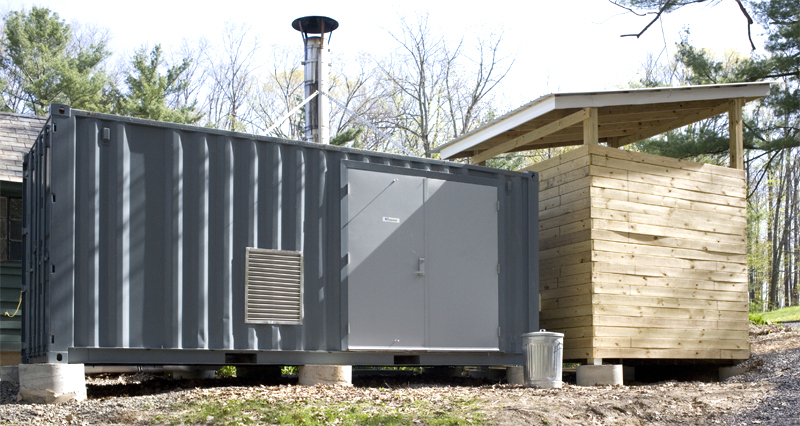
Figure 2. Exterior of new woodchip fired boiler. The wooden feed bin on the right holds about a week's worth of fuel at maximum boiler output. An auger automatically conveys fuel from the hopper to the boiler
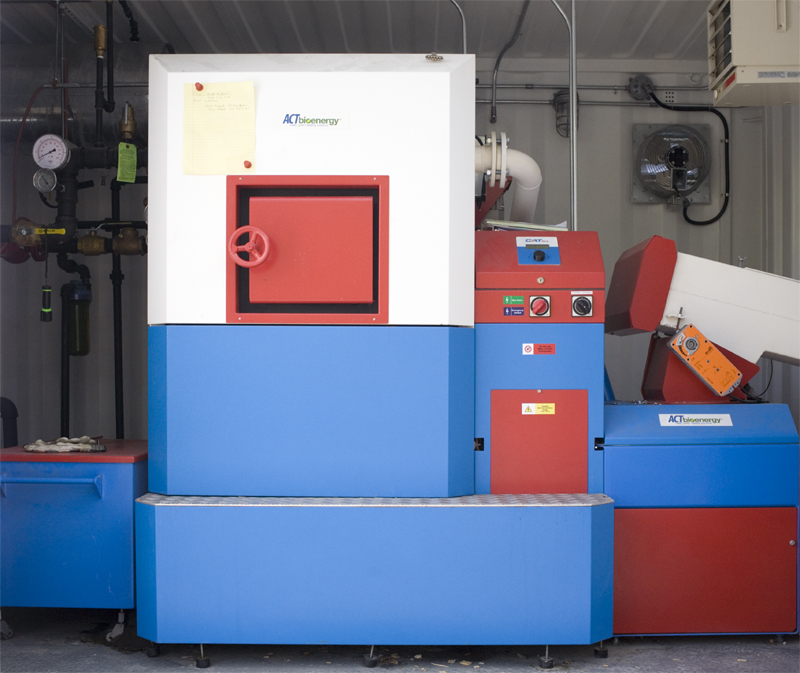
Figure 3. The boiler can produce 400,000 BTU per hour from wood chips
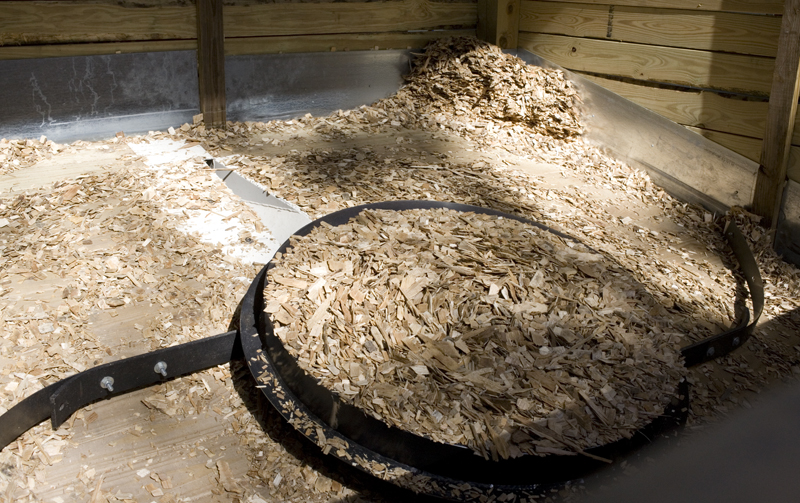
Figure 4. Interior of feed bin (almost empty) showing the sweeper that moves chips across the auger trough
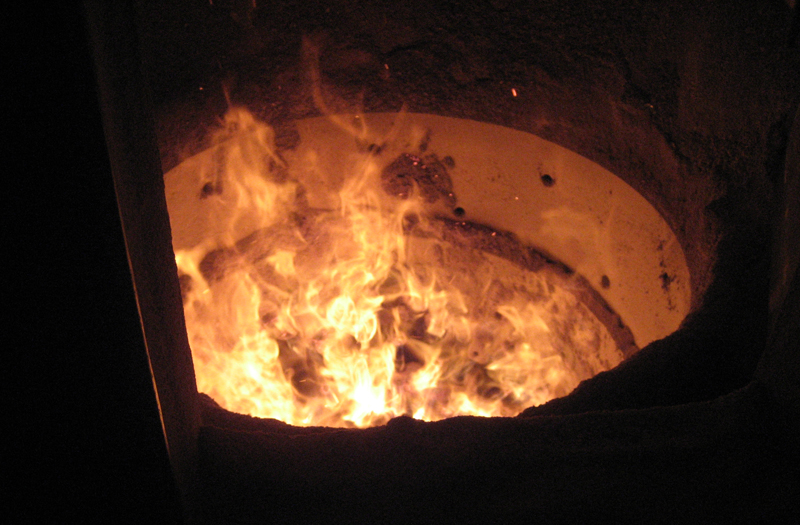
Figure 5. Chips are fed from below to the center of a grate at the bottom of the combustion chamber. Optimal combustion is achieved by controlling the air supplied through holes in the chip bed and holes on the sides of the combustion chamber. The ash produced by this process is less than one percent of the fuel burned
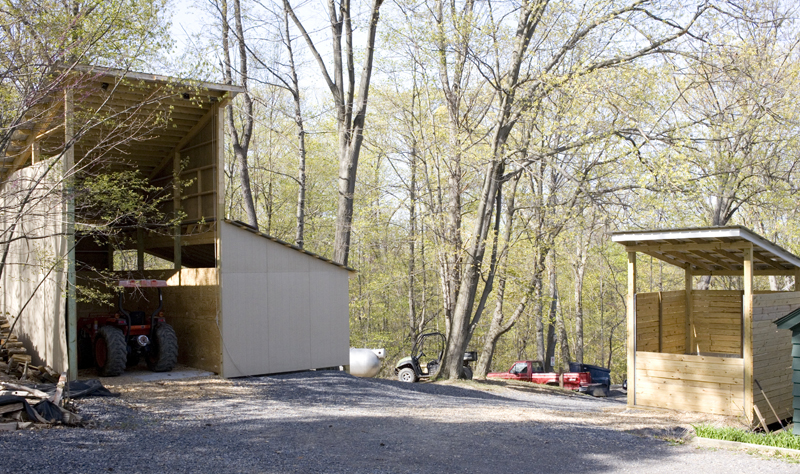
Figure 6. A 12 x 40 foot shed (on the left) stores chips to periodically replenish the feed bin (on the right). The shed was constructed with volunteer help from Cornell Engineers for a Sustainable World
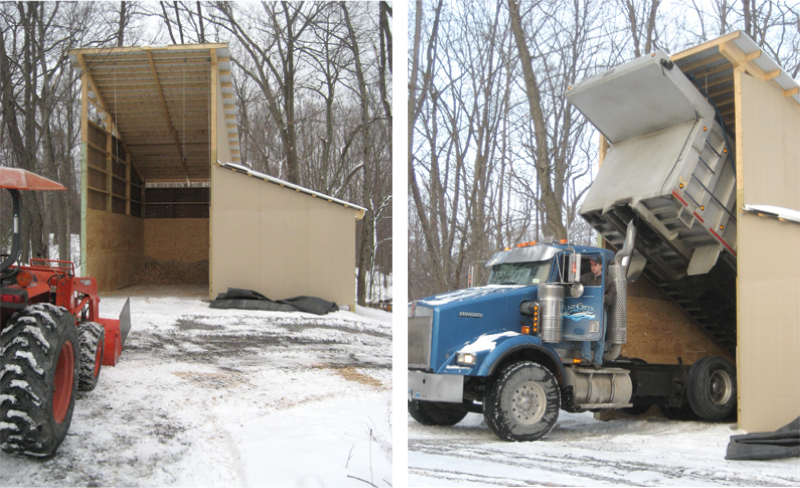
Figure 7. Left: The storage shed in winter and the front loader used to transfer chips to the feed bin; Right: Receiving a 10 ton (50 cubic yard) chip delivery from Mesa Reduction of Auburn, NY. The chips are made from the waste streams of regional lumber mills. In the future, some fuel will come from CNC and other nearby forests
This project would not have been possible without the determined and persistent effort of TC Local contributor and local biomass proponent Tony Nekut. NYSERDA was eager to have a demonstration project, and the Cayuga Nature Center was eager to solve the problem of high propane heat bills, but it took a local activist to bring the need and those with the funding together to make it work. While fuel costs have not yet been tabulated for the year, it is estimated that the new boiler will result in a 50 to 75 percent savings in fuel.
The CNC installation is part of a larger NYSERDA effort to support the evaluation and improvement of biomass-fired heating equipment. According to a recent press release,[4]
The program will clear a path for New York-grown fuels, create new manufacturing jobs, and improve environmental performance of biomass technologies….
ACT’s project at the Cayuga Nature Center in Ithaca, NY, will demonstrate a fully automated, 90 percent efficient wood-gasification boiler technology that is proven in Europe and adapted for the U.S. market. These systems have emissions that are significantly better than conventional wood boilers and comparable to typical oil or gas boilers. Mid-sized buildings (10–100,000 sq.ft.) represent 90 percent of the boiler market in the U.S., and are prime targets for these wood systems which can achieve rapid paybacks when replacing fossil-fuel boilers.
More information on this project is available at http://www.actbioenergy.com/brochure/Cayuga%20wood%20boiler%20photos.pdf
Town of Danby Highway Barns—Project to Retrofit ACT Bioenergy Boiler Using American Reinvestment and Recovery Act (ARRA) Funds
The Town of Danby has a high level of interest in biomass as a heat and energy source. Not only are Town elected officials and staff excited about the potential of making use of a local resource in moving away from fossil fuels, the residents of the Town are also very involved. Citizen involvement is primarily through the Danby Land Bank Cooperative,[5] which “provides an organization and an infrastructure that allows rural property owners to use their fields and forests for grass and wood pellet production.” In the neighboring township of Caroline, Cayuga Biomass Energy, a small group of entrepreneurs that includes TC Local contributor Tony Nekut, is attempting to start a biomass pellet manufacturing plant.
The projected cost to convert the Town’s 10,000 square foot office and truck bay complex to wood chip heat is about $267,000. While the projected fuel cost savings are estimated to be 50 percent or greater, a capital improvement of that scale is difficult for a small rural township to budget or buy bonds for; usually, help from a higher level of government is needed for improvements on this scale. In this case, the Town administration decided to pursue funding under the American Reinvestment and Recovery Act (ARRA)-the federal stimulus package.
As in the Cayuga Nature Center project, biomass proponents helped to bring the need and the source of funds together—in this case, Tony and I helped the Town of Danby make application for these funds by coordinating grant-writing and project specification tasks.[6] In March of 2010, NYSERDA awarded these federal funds to Danby. For its part in the project, the Town will contribute some highway worker hours to the excavation and concrete work needed to construct a covered fuel storage area. The boiler unit, which is almost identical to the one in use at Cayuga Nature Center, will be installed by a regional heating contractor, and the jobs producing biomass fuel will be hyper-local—ideally, in Danby or adjoining Caroline. In fact, the Town Highway crews plan to produce some of the wood chip fuel themselves in the process of keeping the roadways clear. This is a good use of a federal program aimed at maintaining and creating jobs in economically distressed counties like Tompkins.
RPM Ecosystem’s Combined Heat and Power Project/Biomass Demo Plantations
PJ Marshall, one of the principals of RPM Ecosystems[7], wanted to provide the heat and power to operate the firm’s Town of Dryden greenhouses and company headquarters while remaining carbon-neutral. And she wanted to do so using only the products RPM grows—native hardwood trees. Additionally, she sought to develop and demonstrate a biomass plantation system using native hardwood trees planted specifically for a combination fuel/lumber harvest, staged to produce first fuel wood and then lumber, over a number of years, while maximizing forest canopy and carbon sequestration throughout the process. RPM pursued this plan through local Congressman Michael Arcuri, looking to secure a federal appropriation to fund the project.
The company made good progress in developing the project and getting the appropriation drafted last year (2009) but then encountered difficulties when Congress passed a rule requiring that no appropriations go directly to private companies. RPM regrouped and engaged TCAD[8] as a fiscal sponsor for the projects. Heather Filiberto, Director of Economic Development Services at TCAD, describes the agency and its role in the project this way:
TCAD, the County’s lead economic development agency, is a non-profit organization whose mission is to build a thriving and sustainable economy that improves the quality of life in Tompkins County by fostering the growth of business and employment. In situations in which governmental funding must be received by a non-profit, TCAD has stepped in and sponsored applications on behalf of local entrepreneurs in the past. TCAD has agreed to sponsor this request for federal funding on behalf of RPM.
In order to succeed in getting an appropriation in the federal budget for a project, the applicants must obtain letters of support from a wide variety of local officials. The typical support letter is prepared by the applicant in overall substance, then transferred to letterhead and signed by the various elected officials with only slight modifications. The projects are briefly described along with the expected benefit to the community. The following excerpt, from Senator James Seward’s letter, demonstrates the approach.
I am writing to express my strong support for Tompkins County Area Development and RPM Ecosystems Ithaca LLC’s, innovative Dryden, New York, green building and renewable energy project titled Distributive Biomass Combined Heat and Power for CO2-Neutral Facility Operations….
…this project helps install and commission a 200KWe distributive biomass combined heat and power set for sustainable/renewable electricity and thermal energy production in support of RPM Ecosystems Ithaca LLC’s operations.…
TCAD, RPM Ecosystems, and Congressman Arcuri are all hopeful that the funding for this project will be included in this year’s federal budget. Still, the project must wait to commence until the political process runs its course.
Individual Homeowners Can Access Governmental Biomass Incentives
Some government-assisted financing options exist for individual homeowners interested in converting some or all of the heat or hot water produced in their homes to biomass fuels. Anyone who is in a position to benefit from a tax incentive can receive up to 30 percent of the cost of a pellet stove (not to exceed $1,500) in tax savings. A website is available to help with determining whether this program meets your needs,[9] or contact the Pellet Fuels Institute.[10] Local pellet stove merchants can also assist in understanding the program and which units qualify. Unfortunately, stoves and furnaces that burn cordwood are not eligible for these incentives.
NYSERDA also has some homeowner financing programs[11] for the installation of a pellet stove and for the energy efficiency retrofits that can be accomplished in conjunction with a transition to a heat source based on certain kinds of renewable fuel. In general, cordwood stoves and furnaces are ineligible for these programs. For homeowners with low or moderate income, low-interest financing programs, and even some grants, are available through Ithaca Neighborhood Housing Services.[12] Similar programs are available through Tompkins Community Action,[13] and some similar services may be available through Better Housing for Tompkins County[14] as a part of home rehabilitation. All of these housing agencies should be contacted to determine what programs might work best for your individual needs.
Most programs will require that you obtain a professional energy audit to determine which energy improvements may be most cost-effective for you. Even if you don’t use an incentive program, an energy audit can help you to tackle energy investments in the order that gives you the most benefit for the money invested. Conservation measures and efficiency upgrades are often more cost-effective than investing in a renewable fuel heat source. The housing agencies linked above can provide referrals for homeowners of all incomes to qualified energy audit providers and Building Performance Institute (BPI) certified contractors. In most cases, only BPI-certified contractors are eligible to perform work that will qualify for incentives. These energy auditors and BPI-certified contractors are also trained to make use of up-to-date methods and products for saving energy and using renewable fuels.
Funding and Finagling: Negotiating the Political Process to Transition to Biomass
Local, state, and federal governments are involved in energy policy and the implementation of energy projects in a number of different and evolving ways. Even a very savvy and motivated community such as Tompkins County may find it difficult to work the system well enough to get sufficient funding and financing for transitions to carbon-neutral and renewable fuel sources. Over time, government-funded energy efforts at conservation, which should always be the first step in a sustainable energy plan, have become institutionalized in a way that makes them more accessible to homeowners, businesses, and other community institutions. However, renewable energy conversions remain new enough that the path to government sponsorship is not always clear-in both the sense of “visible” and “free of obstructions.”
Some motivated activists claim that the slow grinding of the gears in the public sector is not worth the patience to accommodate. The fastest and best approach when projects are low-tech and inexpensive may be a community barn-raising kind of effort. However, commercial-scale projects in large buildings, or the highly efficient district heat and power systems that group many buildings in a densely developed area on one heating system, can’t easily be accomplished via small-scale community efforts. Both funding and implementation will typically require some level of governmental assist or substantial private investment of capital.
How do thinkers, planners, and activists work most effectively to bring about a transition away from fossil fuel dependence? Understanding the ways that the layers of government divvy up responsibility, and how they do and don’t collaborate, is an important place to start when developing a strategy.
Planning efforts go on at all levels of government—federal, state, regional, county, and municipal. Professional planners are often those who elected officials turn to for information and explanation of policy options, even though elected officials themselves enact policy. It is productive to educate both planners and elected officials about new policies on renewable energy enacted by other governments and to call their attention to demonstrations of new technology. By definition, planners are charged with taking the long view of our situation, and may be the first to show interest in emerging technology and trends. Eventually, however, elected officials must choose to implement new projects.
Those of us, planners or otherwise, who take a long view of our local adjustment to energy descent may consider funding for transitions away from dependence on fossil fuel to be one of the most vital things our governments can do to assure our future security. Implementing that transition can be accomplished by educating elected officials and the professional planners who advise them, and also by applying for and using the funds (grants and capital) and financing (low-interest loans and tax-exempt bonds) for the purpose when such are available. The process is likely to be difficult, even frustrating at times. To lead the way to a renewable-fuels future, we should focus on creating the will, knowledge, and capacity to make good use of every opportunity for implementing projects. The more we show each other how to heat with renewable fuels, the more examples of successful projects will be available to help others understand the benefits. Eventually, we will reach a tipping point at which the logic of using sustainable, renewable sources for our heat and power will make more sense than fighting one another for a rapidly-diminishing stock of polluting fossil fuels.
Notes
[1] http://tclocal.org/2009/10/burning_transitions.html
[2] http://tclocal.org/2010/01/heating_with_biomass_in_tompki.html
[3] http://www.actbioenergy.com/
[4] http://www.actbioenergy.com/news.html#
[5] http://www.danbylandbank.com/site/home.html
[6] Contact Tony Nekut or Krys Cail through the comments section linked to this article if your Tompkins County municipality or school district is interested in pursuing biomass heat funding; we are interested in sharing information.
[7] http://www.rpmecosystems.com/
[9] http://energytaxincentives.org/consumers/heating-cooling.php
[10] http://www.pelletheat.org/3/residential/taxCredit.html
[11] http://www.getenergysmart.org/SingleFamilyHomes/ExistingBuilding/HomeOwner/Financing.aspx
[12] http://www.ithacanhs.org/pdf/LendingServicesWeb020210.pdf
by Krys Cail and Tony Nekut
This article continues the discussion of heating with local biomass begun in our October feature, “Burning Transitions” (http://tclocal.org/2009/10/burning_transitions.html). There it was noted that the best application for local biomass energy is combustion for space heating, possibly coupled with distributed CHP (combined heat and power) electricity generation, and that these technologies are, for the most part, already developed and available in the form of high-efficiency gasifying boilers and pellet stoves.
Work is required along the entire supply chain (growing, harvesting, processing, distribution, and utilization) if local biomass energy is going play a significant role in Tompkins County’s energy future. The traditional economic stakeholders are a diverse group of mutually dependent players (landowners, loggers, foresters, farmers, manufacturers, fuel retailers, and consumers), each requiring commitment from the others to make the system work. Leadership and planning are essential to moving beyond gridlock by demonstrating how, through cooperation, everyone along the chain stands to benefit. Fortunately, there are a variety of case histories and other resources that have been developed in recent decades that render this demonstration somewhat easier.
Barring unforeseen breakthroughs in energy technology, it seems clear that this resource will indeed be developed. Local biomass is already cost competitive with fossil fuels for space heating, and its economic viability will only improve as fossil fuel prices continue to rise. The time has therefore arrived to begin development, because time will be required build the needed infrastructure.
The scale of the local biomass development challenge
Every form of biomass yields about 16 million BTUs per dry ton when burned. Sustainable annual biomass productivity ranges from about 0.5 dry tons per acre for our local forests to 5 dry tons per acre for some locally suited energy crops. These productivities represent conversion efficiencies from solar radiant energy to stored chemical energy of about 0.1 to 1 percent. If half of Tompkins County’s 300,000 acre land area were committed to growing biomass, the annual per capita energy production would range from about 12 to 120 million BTUs. (See the discussion of County land cover in the October “Burning Transitions” article.) By comparison, current (2007) statewide annual per capita primary energy consumption is 219 million BTUs. In other words, the amount of biomass energy we could get from our land even in relatively rural Tompkins County would yield nowhere near our total energy needs.
Meeting our heating needs is another matter. Each household in the County uses about 100 million BTUs annually for water and space heating; this is about 43 million BTUs annually per capita — approaching the range of sustainable large-scale local production. Adding the wholesale implementation of residential energy efficiency measures would bring total heating energy self-sufficiency within reach. Ed Marx, Tompkins County Commissioner of Planning and Public Works, has been quoted as estimating that biomass could heat up to 40 percent of the homes in the county, or even more if homes were super-insulated.
The biomass heating gap
Local biomass energy for heating has enormous potential benefits. It creates jobs, keeps money local, provides energy security, reduces CO2 emissions (locally burned biomass is virtually carbon-neutral), increases carbon sequestration, slows fossil fuel depletion, improves forest and soil health, maintains rural land values, reduces development pressures, creates community ties, and raises community environmental awareness. But fewer than 5 percent of County homes are listed in census data as heated primarily with biomass (cordwood and pellets). For 2008, the Census Bureau’s American Community Survey estimates the percentages shown in the following diagram for heating the 37,749 occupied housing units of Tompkins County.
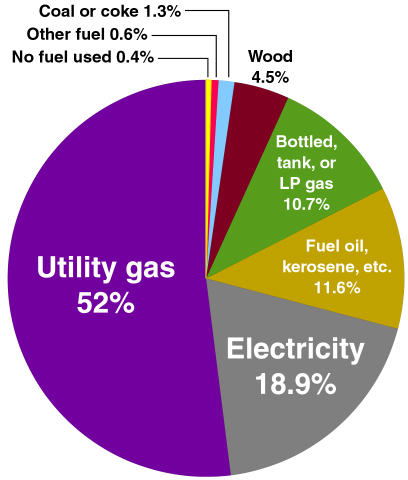
The apparent lack of interest in heating with wood shown by the 4.5 percent figure is partly an artifact of the way the data is gathered and partly due to active discouragement of wood heat by mortgage lenders and insurance companies.
Wood heat appliances do not enjoy wide acceptance by those who underwrite mortgages and insure homes. Due to the perceived risk of fire, many underwriters of homeowners insurance will not insure properties with wood stoves. (Pellet stoves, which are less likely to cause chimney fires, are a bit more acceptable.) In particular, homes that include rental units — even if the home is also owner-occupied — are very difficult to insure if there is wood-burning equipment in use for heating and the insurer is aware of that fact.
Of course, homeowners insurance is a requirement for any house that has a mortgage. But it is not just the reticence of homeowners insurance underwriters to insure homes with woodstoves that limits use of this technology; there is also a problem associated with wood heat when the lender packages the mortgage for resale on the secondary mortgage market. Despite the worldwide use of this simple technology, burning wood to heat a dwelling is perceived as too risky. Where woodstoves are a secondary, rather than primary, source of heat, this is overlooked. But a home that relies predominantly on wood for its heating source is a home whose purchase will be difficult to finance.
Gaining a more accurate estimate of local trends
This situation — which makes it plausible to add wood heat as a secondary heat source, but difficult to rely on it as a primary heat source — helps explain why the census figures for wood heat seem so low. This is a problem even in the decennial direct counts.
The between-decades estimates suffer from an additional problem: there’s no mechanism for reporting a local trend. Households demographically similar to the various household types in Tompkins County are surveyed at various locations around the country, and the composite picture of their changes is applied to local households with similar characteristics. For instance, if upper-income professional couples with two or fewer children in the home were, for the most part, heating with natural gas across the US, there would be no mechanism for the American Community Survey to read a recent upswing in purchases of woodstoves and pellet stoves among local college and university faculty.
To get a better idea of what’s really happening locally, we had to ask around. The results, while anecdotal, point to just such a trend.
The sales managers of both local woodstove/pellet stove retail outlets indicated that business has been steadily increasing throughout the decade, with particularly noticeable upswings in wood heat appliance purchases when other forms of fuel — particularly fuel oil — experienced price run-ups or price volatility. Both described their typical customers as college professors or other professionals interested in saving money and in helping to conserve non-renewable resources. While families living in more rural and suburban locations were the norm for local wood heat users at the beginning of the decade, the increasing popularity of pellet stoves has resulted in more urban families buying wood heating appliances.
A construction manager at Ithaca Neighborhood Housing Services, which administers a group of NYSERDA programs aimed at green energy for heating, concurred that more urban residents are choosing pellet stoves, and that the help available from NYSERDA resulted in more low- and moderate-income families being able to access affordable financing to add wood heat to their homes.
Another indication of the rising local popularity of wood heat of various sorts is the brisk business that fuel purveyors are doing in cordwood and pellets. The owner-operator of Finger Lakes Firewood, the largest local cordwood dealer, has purchased additional automated equipment to better clean and move his cordwood as his customer base has continued to expand. Ithaca Agway has been using its display sign to advertise pellets, and the Home Depot devoted as much space at the front door to sale-price wood pellets as to the snow blowers.
Industrial uses of wood heat
Wood heat is beginning to appear in local industrial operations, too. For example, US Salt in Watkins Glen is in the process of converting the heating of its large facility on Seneca Lake to biomass.
According to Len Boughton, an engineer with the firm who has been responsible for overseeing the construction and retrofitting, the system, after two years of work, is now in place and operational, but the switch to wood-based fuel will wait till March to allow troubleshooting during a season of less extreme heating demand.
Plant Manager Frank Pastore said that US Salt has contracted with TreeSource Solutions (http://treesourcesolutions.com/) to avoid the management burden of dealing with multiple suppliers. TreeSource is a wholly owned subsidiary of Catalyst Renewables (http://www.catalystrc.com/). Pastore said that he expected the bulk of the fuel to come from local sources, through the Wood Yard that TreeSource has established nearby in Burdett, but that he trusted the contractor to source wood fuel as appropriate in order to maintain a stable and affordable price.
Buying and selling biomass in Burdett
The Wood Yard at the old railroad depot in the Village of Burdett was, in its last incarnation, a steel recycling facility, and many of the buildings are simply being reused “as is” the old depot itself is used as a scalehouse for weighing trucks. The facility includes a large, rambling lot with a gated entrance from State Route 79. The Yard was not officially open the day of our visit, but it’s clear that the facility is used in a number of synergistic ways in addition to providing a means to weigh and store wood intended for use as biomass fuel.
Entrance to the Burdett Wood Yard
A recently constructed pole barn houses a portable bandsaw mill, and some rough-milled lumber showed that the facility is in active use. A large pile of logs awaiting conversion to woodchips was evidence of the yard’s role as a source of fuel, though there was no tub grinder on site. A tub grinder, which can cost up to a million dollars, is typically portable over the road system and will presumably be brought onto the site to process the logs as needed.
Portable bandsaw mill at the Burdett Wood Yard
Arrangements for dropping off wood and arranging payment are made directly with TreeSource Solutions’s buyer, Jack Santamour, who spends most of his time at TreeSource’s facility in the Adirondacks and manages the Burdett yard via telephone with the help of some local employees. TreeSource is currently buying logs by the ton every Friday or by appointment.
Wood awaiting processing by TreeSource Solutions
A cooperative model of biomass production in Danby
One key to sustainable local wood heat in Tompkins County is the creation of a system whereby local landowners can convert otherwise unused or underutilized farm or pasture land to biomass production. The Danby Land Bank Cooperative (http://www.danbylandbank.com/) provides an organization and infrastructure that allows owners of 10 or more acres in the Town of Danby to use their fields and forests (much of it marginal for farming) for grass and wood pellet production.
Built on a classic cooperative model, the goal of the Land Bank is “to unify fragmented and non-farming rural landowners to form a large enough agricultural base to provide economies of scale.” Local members of the co-op lease their land to be harvested of perennial grasses as feedstocks for grass pellets or briquettes; the land is cleared for free, and the owners receive tax credits and, eventually, a share of the profits.
In operation barely a year, the DLBC has already gained 20 owner-members with more than 350 acres devoted to the project. Governance structures are in place, and plans are in the works to incorporate as a legal cooperative. The project, aided by consultation with the County Planning Department and close cooperation with Cornell Cooperative Extension, received major publicity in November with the appearance of a feature article in Rural Cooperatives, a publication of the U.S. Department of Agriculture (www.rurdev.usda.gov/rd/pubs/RuralCoop_NovDec09_Final.pdf).
First hay cutting of the Danby Land Bank Cooperative (photo courtesy of DLBC)
Establishment of a local pelletizing plant has been identified as a key to long-term sustainability and economic viability through reduction of transportation costs. The pellets, which are manufactured by grinding, drying, and extruding raw biomass into a dense, free-flowing fuel of consistent quality that can be efficiently used in inexpensive residential appliances, have a retail market value per dry ton well over twice that of the raw feedstocks. The value added more than covers manufacturing costs, so pelleting can provide an economically viable link between local biomass suppliers and the existing local pellet market.
The DBLC recently joined with Energy Independent Caroline to sponsor Town Hall meetings in Danby and Caroline regarding a company called Community Biomass Energy, which proposes to build a local biomass pelletizing mill on Boiceville Road in Caroline just south of State Route 79. (Disclosure: One of us (Nekut) is a principal in this effort.) See the DBLC’s newsletter (linked from their web site) for details and updates. The December 2009 issue is at http://www.danbylandbank.com/site/resources_files/DLBC_Newsletter_Dec_2009.pdf.
Unresolved issues
Local biomass harvesting and processing hold great promise for reestablishing the county's ability to provide for its own heating needs. However, several issues remain unresolved.
We need to relocalize food production, too. While much of the land in the county that could produce biomass for heating is marginal for raising cultivated crops, a substantial percentage of that land could alternatively serve for rotational grazing of livestock, which is arguably a less-intensive, lower-input use of the same acreage. Thus the optimum allocation of land for biomass production vs. land for grazing or the production of winter hay remains an open question whose eventual resolution will depend on a number of variables that are difficult to predict.
The increased use of biomass for heating will increase economic incentives to harvest wood resources beyond a level that's sustainable. The large-scale reversion of former Central New York farmland to successional forest over the last half century makes it easy to forget how quickly the forest can be cleared again. The establishment of sustainable forest management practices will be essential to the return of biomass heating as a long-range relocalization strategy.
The rediscovery of biomass as a heat source has created a market for American wood chips as far away as Europe. Our region's potential as a major biomass producer also makes it susceptible to the kind of resource exploitation we associate with third-world countries. Heating our homes with local biomass won't succeed if higher prices cause local biomass to be exported rather than used locally.
The need for greater local control over the allocation of our local resources argues for the establishment of biomass harvesting and processing facilities under local management and provides further reason to hope for the success of initiatives such as the Danby Land Bank Cooperative and the proposed Community Biomass Energy facility in Caroline.
Online wood heating resources
Cornell Cooperative Extension has posted an excellent collection of links to articles on firewood resources and heating with wood on their statewide web site at
http://cce.cornell.edu/Environment/Pages/HeatingwithWood.aspx
How Planned, Localized, Sustainable Non-food Biomass Utilization Can Help Ease Energy Descent and Mitigate Global Climate Change
by Krys Cail
Introduction
This article provides a framework for considering the socio-economic structural changes that can lead to a different, more stable, and more sustainable local market for heating fuel and electrical energy.
The use of combustion for heat and power is an established and developed technology, while the successful social balancing of environmental and ecological costs with short-run economic benefit is a new, and daunting, challenge. The change, or transition, needed to use the locally available resource of non-food woody and grassy biomass to help solve current energy problems is socio-economic change, not technical innovation. We can supplant at least some current fossil fuel use with the more carbon-neutral combustion of earth surface harvested feedstocks using current technology. Nonfood biomass direct combustion[1] can be undertaken in a localized context. We can take an enlightened approach to the sustainable management of feedstock planting, growing, and harvesting, energy-efficient processing, complete and clean burning, and ash recycling. Developing such a system also offers a means of developing the alternative commercial channels necessary to move the Tompkins County area to a future of heat and energy production that is not just more environmentally friendly, but also more economically insulated, or decoupled, from the gyrations of the world oil market in a time of post-peak oil.
Other current and emerging heat and power technologies, such as solar, wind, geothermal, and small-scale hydro are “greener” forms of alternative energy and may be our future mainstays. However, in biomass-rich locations like Tompkins County, the economic attraction of biomass as an affordable substitute for fossil fuels will ensure that it will come into commercial use as oil and other energy commodities rise in price. If the development of biomass energy is controlled by the current energy industry, large energy companies will guard their market share by organizing only large-scale markets, even in situations where energy efficiency favors smaller, more localized scale. Conversely, building localized commercial structures to sell nonfood biomass-generated heat and electrical energy could feasibly provide a template for the effective investment in and commercialization of localized energy from other, greener sources in the future.
The kind of community development that allows areas the size of Tompkins County to become more energy self-reliant—”import substitution” for the energy products of the fossil fuel industry—can accomplish the twin goals of creating green jobs and modeling the kind of less global, more local commercial/economic interactions that are referred to as relocalization. Relocalization of energy provision is a necessary response to energy descent; accomplishing this using tested community development practices will ensure better success in the required transition.
The First Two Burning Transitions
Combustion (fire), used as a tool, was a major human cultural advance, and perhaps helped our species to evolve. In his recent book, Catching Fire: How Cooking Made Us Human,[2] Richard Wrangman, a Harvard University biological anthropologist, postulates that the taming of fire, and its use to cook food, was the key tool-using event that allowed human evolution to proceed from pre-human hominid to modern humankind. He postulates that cooked food allowed us to divert calories from chewing to growing larger brains.
The centrality of fire to the establishment of human society is also evidenced in religions and belief systems worldwide. One classic rendition is the myth of Prometheus, the champion of humankind who was said to have stolen fire for use by mortals from the immortal gods.
From ancient times up until the Industrial Revolution, humans used combustion sustainably, with only localized or regional instances of deforestation.[3] Early burning was carbon-neutral as far as the earth’s atmosphere was concerned.
Some primitive peoples did set massive fires. For instance, Plains Indians used prairie fires to stampede buffalo over cliffs; Tompkins County’s first peoples probably (like New England’s natives) routinely burned the forest understory to make for easier hunting access;[4] and innumerable horseback European raiders ransacked and ruined settled villages with fire—as Revolutionary War General Sullivan did here in the Finger Lakes. These combustion materials were already a part of the earth surface/atmosphere carbon exchange. In geologic/atmospheric time, even very big surface fires are just blips. The carbon released into the atmosphere would have otherwise been added shortly anyway through decomposition. It was the Industrial Revolution and the use of first coal, and then oil and natural gas, that began the process of unbalancing the planet’s atmospheric carbon load by making use of the carbon stores of former eons, previously safely buried underground. This led to both global climate change, and to the depletion of easily extractable in-ground carbon sources we speak of as peak oil and energy descent.[5]
The first “burning transition,” then, was the Prometheus transition. This transition changed humankind (if you don’t believe Richard Wrangman that it changed our evolution, you must at least concede that it drastically altered our culture). The Prometheus transition enabled the development of agriculture and led to deforestation in a few subcontinental areas But the second burning transition—and the advent of the steam and internal combustion engines of the Industrial Revolution—resulted eventually in major land and sea transformation and widespread ecosystem and climactic change. The first burning transition changed humankind, while the second burning transition changed the planet. Each burning transition also markedly changed the socio-economic systems that people used to regularize and control the commercial and familial relationships that provide us essentials such as heat in cold weather, food, and, after the second burning transition, electric power.
Planning a Third Burning Transition
Technological optimism about alternative fuel development usually focuses on replacing combustion of “dirty” fuels with combustion of “clean” fuels, while leaving the production and distribution systems for liquid and gaseous fuels and electrical power in its heritage configuration. That configuration is controlled by some of the most powerful international corporations on earth—oil and gas developing, refining and shipping companies, electrical utilities, and coal-mining and shipping companies. These actors have a vested interest in seeing that the socio-economic systems of the future do not deviate too much from those of the past, ensuring these corporations continued market share. Is that to our advantage?
Is the needed change limited to a substitution of one fuel for another, one feedstock for another, or one power source for another, with no substantive change to social, industrial, political, or economic institutions? Or is a more substantive transition needed? Will social and economic change follow technology, or will we invent and popularize only the technologies our social and economic systems predispose us to aim toward?
“Local planning for sustainable use of local resources” is the basis of egalitarian post-colonial social and economic development. It is also the key to the development of a third, socioeconomic/cultural burning transition. Rather than assume an international market in energy as a given and hope for technological fixes, we should focus in the third burning transition on the relocalization of systems of sourcing, producing, and distributing heat and power. In that context, the on-going technological development can be decoupled from the economic fortunes of transnational corporations that are difficult to call to account on environmental effects in any particular place. A different kind of optimism about confronting the challenges of global climate change and peak oil can be envisioned, one in which the needed change in socio-economic structures is the direct goal, in order to accomplish the most efficient and environmentally-sound use of energy within current technological and environmental limits. This might then be followed by additional technological advancement, as needed and affordable—perhaps even a Solar or Geothermal transition that makes burning itself unnecessary. However, those possibilities are too far away for a complete transition right now, and right now is when global climate change must be addressed. Rather than trust humanity’s on-going scientific and technological innovation to “come up with something” that will make unfettered world markets in energy able to function within environmental limits, this optimism postulates that human communities can learn to balance their own energy needs with the sustainability of their own environments through socio-economic or socio-political progress.
The third burning transition is, in essence, a relocalization of energy production and an implementation of the household and commercial structures needed to manage more local production and consumption of energy, one that brings the source and use points of energy geographically closer together. This is a transition that requires no new or special technological development, but rather advancements in business form development and industrial design, including business and consumer combustion equipment and new approaches to the design of district heating and electrical power grids.
The Need for a Local Approach
Localities differ in what kind of resources they have available to produce heat and power. Thus far, most research and development in the area of biomass use as an alternative energy feedstock has used a non-localized model. Raw biomass is generally first converted into liquid fuel (both corn-based and cellulosic ethanol are liquid fuels), and then distributed via pipeline, tanker, and tanker truck, similar to petroleum. Or, alternatively, biomass is burned directly, but the resulting heat is made into electric energy and distributed far and wide on the electric grid. Both of these models contain large distributional inefficiencies.[6]
Government subsidies for one form of fuel over another can have unforeseen effects. Often, governments subsidize use of “cleaner” or more carbon-neutral fuels or combustion equipment via a direct consumer subsidy, such as a tax credit, or an indirect subsidy, such as a producer tax break or capital investment in production plant and equipment. Corn ethanol—an alternative fuel that even its promoters are now seeing as a “transitional” alternative fuel—is an example of how governmental enthusiasm for jobs, plant, and equipment in every legislator’s district can result in a glut of relatively expensive alternative fuel production in remote areas, with little hope of export at a profit in the face of price variation in the oil markets, where the product competes directly.
Some European governments have backed the development of small-scale solid-fuel biomass combustion, from pellet stoves to wood-chip furnaces to multi-fuel-burning combustion units and ultra-efficient gasification boilers that power electric generators as well as district heating grids. While this has led to much more widespread adoption of the technologies than in the US, there are still some perverse global-market effects. The governmental support for wood pellet burning in Northern Europe (direct consumer subsidies for pellet stoves, for instance) has resulted in the US market for wood pellets being significantly impacted by European demand: shortages of wood pellets in both the US and Europe in recent years have been blamed, in part, on the fact that most wood pellets produced in the US are shipped, under contract, to Europe, rather than available for growing domestic use.[7] If the domestic demand for wood pellets rises because fuel oil rises significantly in price, manufacturers can’t satisfy it, and resulting shortages drive up wood pellet prices in tandem with fuel oil prices.
Government support for the development of green energy is surely needed. But, as illustrated above, direct support for particular technologies can have perverse outcomes, when, in the real world, the variable and uncontrollable price of oil interferes with orderly marketing of the product as a substitute for the fuel and power sources people are accustomed to using. For that reason, localized community-controlled energy development for heat and electricity is preferable, as it can reasonably allow a community or geographic region to claim its own energy resources and begin to decouple its energy costs from the world oil market. In addition, as is the case with consumers developing commercial relationships with their local farmers, a measure of consumer loyalty and flexibility can be gained by localizing the transaction.
Local Resources: Prime Determinant of Appropriate Combustion Feedstocks
The third burning transition will look different in different locations. Relocalization offers the opportunity for each region or locality to assess what underutilized or sustainably developable resources it possesses, as well as what market power its heat and energy consumers represent. The skills and resources of local people must be accounted for, as well as underutilized natural resources and plant and equipment in the built environment. This assessment of resources can be done as a part of a tried and true methodology of community and economic development—Asset-based Community Development.[8] An asset-based approach to community development allows for customizing programmatic goals to highlight natural resources, human capital agglomerations, and other local conditions that will make one form of biomass more feasible to use as a feedstock for combustion than another.
The local foods movement has made some use of the phrase “Eat your landscape.” The idea is that, by engaging in an ongoing direct involvement in growing food (gardening or CSA working membership) or direct-from-the-local-farmer commercial interaction with a manager of food producing lands in your locale (“landscape”), one can exercise, in common with one’s neighbors, some influence over what kind of a landscape it is now and in future. The goal is use that is environmentally sound, sustainable, and provides a living wage to those who manage and work the land.
A similar approach can be taken to the orderly and sustainable harvest and cultivation of biomass for combustion in place of oil, gas, and, especially, coal. Although these fuel substitutions are not the ultimate long-term solutions to our energy problems, they do offer us a mechanism for developing the distributed, local commercial interactions that can and will set the stage for the development of more long-term sustainable energy systems. In much of Tompkins County, for instance, woody and grassy biomass may be available for use as a combustion fuel, but the commercial infrastructure to sustainably and profitably grow, harvest, and process that biomass needs to be developed. Without a community development effort in this area, woodlands and pastures in Tompkins County will continue to fall into an unused and unmanaged condition that does not allow for optimum carbon sequestration and invasive plant control and does not support the development of local energy and green jobs.
In Tompkins County, most of the underutilized resource is privately owned forested or pasture/hay land that is minimally managed and, in some cases, is becoming overgrown with invasive brush species. The following chart shows the acreage of various types of landcover in the county.

The accompanying map shows a pattern of land use that conforms to topography: the northern portion of the county, which is composed of flatter land and relatively more of the better soils for agricultural use, has a greater percentage of acreage in cultivated cropland and pasture, while the southern, hillier portion of the County is more densely wooded.
Organizing for Local Energy Production and Consumption of Biomass
“Eat your landscape” implies sustainability. A bountiful landscape might continue to provide food over decades, centuries, even millennia if it were properly managed and husbanded. “Burn your landscape” has none of the overtones of sustainability—it seems, rather, cataclysmic: a landscape devoid of living things.
There are other options, however. An actively managed forest or hayfield can continue to produce biomass for combustion purposes over a long period of time if attention to the ecosystem allows for the return of depleted soil nutrients through ash spreading and the building of fertility through support of various plant and animal communities. Woodlands actively managed for sustainable harvest of woody biomass could provide plant and animal habitat, sequester carbon, and produce some hardwood lumber as well. The key here is the way in which natural resource lands are managed. Under some systems of management, carbon sequestration and selection to impede the advance of invasive species are optimized, creating a forest that is more hospitable to native flora and fauna and more able to ameliorate the excess atmospheric carbon than the previous unmanaged woodland. However, such management systems are not the most economically viable under current market structures.
Current economic structures, if left unchecked, could cause cataclysmic environmental damage as harvested biomass becomes less costly than oil. Clear-cutting woodlands, while devastating to natural communities and water quality, is the cheap way to amass a large tonnage of biomass in an area like Tompkins County. Utility companies buy wood-chip tonnage to co-fire with coal from low bidders, developing an industry built around mechanized, invasive forest destruction. Environmental regulation has proven to be a weak tool for controlling industries that have a market incentive to use forests or grasslands as a short-term, rather than permanent, resource. An example is the Catalyst Energy/Treesource Solutions biomass aggregation facility in nearby Burdett, Schuyler County, which is offering loggers one low price for biomass tonnage to be used as wood chips to heat and power the US Salt plant in Watkins Glen.
On an individual scale, landowners who use firewood for heat are likely to take the long view of their investment in their land and do their best to manage their woods to maintain sustained production as well as multi-functionality (use of the woodlands for additional purposes, such as wildlife habitat, hunting, nature appreciation, privacy). When surveyed, owners of rural acreage in Tompkins County were amenable to seeing their underutilized parcels of land produce an income stream—but very few had either time or capital to devote to this.[9]
Several local initiatives in Tompkins County have sprung up to test structures that might become a part of a third burning transition here. In the Town of Danby, landowners have come together to market the biomass from their properties (as well as potentially other land-based products) as a group. This organization of owners of fallow fields and under-managed woodlots is based on the producer-coop configuration that has been successful in some agricultural areas.[10]
Another effort, spearheaded by Anthony Nekut, is intended to draw together investors and entrepreneurs with the purpose of developing a medium-scale pellet production facility in the county. Tony would like such a plant to have the capacity to palletize both woody and grassy biomass, and he envisions both local sourcing of biomass and local sales of pellets for home and business heating. [An article by Tony is scheduled for future publication on tclocal.org.—Ed.]
A third approach to using biomass to supplant some of the fossil fuels used for home heating in Tompkins County is Abbot Development’s initiative to develop Cornell University workforce housing on a Danish-style district heating model, with a combined heat and power plant as an integral feature of the development. This plan is currently in concept development stage, but it could easily be implemented if chosen by Cornell as the model for their new housing development. Again, the technology is available and ready to use; it is the commercial market structures that require some developmental attention to establish such a project in this country.
A fourth local project focuses on commercial combined heat and power along with a managed woody-biomass plantation scheme: RPM Ecosystems, a Dryden company involved in the production of fast-growing nursery stock for reforestation projects worldwide, has worked with Congressman Michael Arcuri to obtain federal funding for a demonstration project. The project involves a wood-fired combined heat and power plant that would provide heat for the greenhouses and offices of the nursery along with sufficient electrical power to operate the facility. Additionally, plantations of RPM Ecosystems trees would be established with a goal of producing some biomass along with some hardwood lumber while maximizing forest canopy (and carbon sequestration) throughout the growth and development of the tree farm.
One approach that is not currently in evidence in Tompkins County, but might be worth investigating, is the “CSE.” CSE stands for “Community Supported Energy,” and it is modeled on the successful CSA (Community Supported Agriculture) structure. This is something of a consumer cooperative: energy consumers that would like to use local resources to produce energy band together, and, through pooling investment funds, establish critical mass to bring a production facility on-line, which they pledge to support through their energy purchases. This model was first promoted by environmental advocate Greg Pahl, and has been tried with some success in Vermont.[11]
Conclusion
The above examples merely scratch the surface of possible structures for relocalizing our heat and energy markets. And the traditional approach should not be ignored, either: use of cordwood for home and business heating has increased markedly as fossil fuel prices increase and can be expected to continue to increase, particularly in rural areas of the county. More people now make a main business or a profitable sideline of harvesting firewood, or buy less fossil fuel because they harvest some firewood for their own use. Several local retail outlets and service businesses sell and/or install combustion equipment, and technology refinements have made cordwood burning cleaner and more efficient than it was in the past.
A third burning transition—based on community development and economic innovation—is needed if we are to avoid the worst potential effects of global climate change and post-peak-oil economic instability. In the first burning transition, fire changed humankind; in the second, humankind using fire changed the world until disaster threatened. In the third burning transition, humankind must organize new structures of production and exchange to socially contain the power that unlimited individual fire-use unleashes on the world, to protect both the species and the environment on which it depends. In the future, the structures so organized can be again transformed, in a fourth burning transition, to non-carbon-based feedstocks such as the sun’s direct energy, geothermal heat, and wind and wave energy.
Notes
[1] “Direct combustion” refers to biomass burned as a solid fuel, not a liquid or gas fuel product or fuel additive.
[2] New York: Basic Books, 2009.
[3] Localized or regional deforestation should not be underestimated in its capacity to decimate human, animal, and plant communities, including driving some species to extinction. It does not, however, represent a pattern of world-wide changes, despite its severe impact on circumscribed areas.
[4] Cronon, William. Changes in the Land, Revised Edition: Indians, Colonists, and the Ecology of New England. New York: Hill and Wang, 1983.
[5] Biomass/ethanol/biodiesel schemes dependent upon intensively cultivated food crops like soy or corn fail to break the connection between the oil market and alternative fuel if a system of petro-chemical input dependent agriculture is used. They also raise grave ethical concerns, commonly referred to as the “food-fuel controversy.”
[6] While current average distributional losses for electrical energy are in the range of seven percent, biomass resources, like solar resources, may be located at a greater distance from urbanized areas than existing power plants, resulting in even larger distributional losses or larger amounts of transportation energy to move the raw material closer to the point of use.
[7] More on the international market volatility of wood pellets is available in the Renewable Energy World magazine article “Time for Stability: An Update on International Wood Pellet Markets,” Feb. 4, 2008. Available at http://www.renewableenergyworld.com/rea/news/article/2008/02/time-for-stability-an-update-on-international-wood-pellet-markets-51584
[8] See The Asset-based Community Development Institute at http://www.abcdinstitute.org/ or Wikipedia on Asset-based Community Development at http://en.wikipedia.org/wiki/Asset-Based_Community_Development
[9] Cail, Krys. Tompkins County Landowners Survey. Report for Cornell Cooperative Extension of Tompkins County on the results of a mail survey of owners of large parcels of rural land in Tompkins County undertaken by the Green Cities class of Cornell University’s City and Regional Planning Department in 2005.
[10] Begun as a project for Elizabeth Keokosky’s masters degree in City and Regional Planning at Cornell University, this initiative has progressed to the point of establishing a local steering committee and is in the process of drawing up incorporation documents.
[11] Pahl, Greg. The Citizen-powered Energy Handbook: Community Solutions to a Global Crisis. White River Junction, Vt.: Chelsea Green Publishing, March 2007. See also Renewable Energy World magazine, “Community-supported Energy Offers a Third Way,” Greg Pahl, March 12, 2007. Available at http://www.renewableenergyworld.com/rea/news/article/2007/03/community-supported-energy-offers-a-third-way-47700


